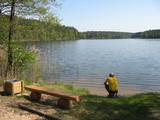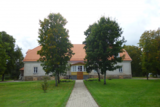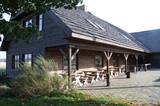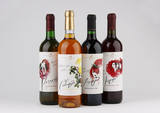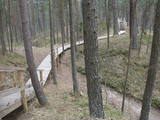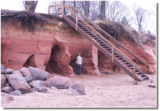| Nr | Nosaukums | Apraksts |
|---|---|---|
|
Atpūtas māja Surfhunt atrodas tikai 100 m attālumā no Rīgas jūras līča smilšu pludmales, 70 km no Pärnu. Atpūtas māja piemērota ģimenēm un draugu kompānijām, kas vēlas doties dabā vai aktīvi atpūsties, piemēram, sērfot. Šī vieta īpaša ar to, ka viesi paši var ņemt grozus un doties uz lauka salasīt ražu, no kuras arī paši var sev pagatavot maltīti. |
||
|
Krogs "Minhauzens Pie Bocmaņa" atrodas Salacgrīvas centrā – Bocmaņa laukumā pie Salacas. Kādreiz tik pazīstamais krodziņš „Pie Bocmaņa” ir ieguvis jaunu interjeru ar barona Minhauzena tematiku. Latviešu virtuve: Siļķes salāti, siļķe ar biezpienu, zivju zupa, cūkgaļas krūtiņa ar sīpoliem, pelēkie zirņi ar speķi, ceptas aknas, cepta bute, cepta zandarta fileja, rupjmaizes kārtojums. |
||
|
Centrālā un arī skaistākā Traķu iela, kas ved cauri Traķu pussalas ziemeļu daļai, ko kādreiz sauca arī par „Mazo pilsētu”. Ielas abās pusēs ir redzami visdažādāko krāsu koka namiņi. Te jāatceras, ka tipiskai karaīmu mājai uz ielas pusi ir vērsti trīs logi! Karaīmu ielas rietumu pusē (Karaīmu 30) atrodas viens no retajiem pasaules karaīmu lūgšanas dievnamiem – kenēze (kenesa) – vienstāva koka ēka ar zilganu jumtu. Savukārt, ēkā Karaīmu ielā 22 ir izveidota etnogrāfiska izstāde (Karaimų etnografine paroda). |
||
|
Apvidus veidots neregulētās Daugavas augšteces ielejas, dabas un kultūrainavas un bioloģiskās daudzveidības aizsardzībai. Parka teritorijā ir izveidotas dabas takas, velomaršruti, bet Daugava ir piemērota braucieniem ar laivām. Teritorijā ietilpst Daugavas loku dabas parks (sk. sadaļu „Dabas parki”). |
||
|
Ances muiža ir būvēta kā tēva dāvana dēlam Ulriham Johannam fon Bēram. Pie muižas bija izveidots grezns franču dārzs. Pēc 1766.gada ēka tiek pārbūvēta un grezni izrotāta, ēkai šajā laikā ir divi stāvi, kuriem ir lieli logi un parketi. Visas durvis, koka griesti un paneļi bija darināti no ozolkoka un bronzas dekorēti. Skaisti kroņlukturi, marmora kamīns un liels skaits spoguļu papildināja iekārtojumu. Ap 19 gs.10.gadiem tajā iemitinās franču kareivji un nodara tai lielus postījumus. Tādēļ mazliet vēlāk otro stāvu nojauc un veicot plašus remontdarbus muižu pielāgo pārvaldnieka un ierēdņu dzīvokļiem. 1920.gadā Ances muiža tiek atsavināta tās pēdējam īpašniekam Georgam Bēram un nonāk valsts īpašumā. Tagad ēku apsaimnieko pašvaldība un tas izveidots par Ances pagasta sabiedrisko centru. Atjaunotajā ēkā saimnieko rokdarbnieku kopa „Paukers”, var iegādāties dažādus amatnieku izstrādājumus vai kopā ar Ances Sklandraušu cepšanas asociācijas meistariem izcept sklandraušus. |
||
|
Viens no populārākajiem Kurzemes piekrastes tūrisma objektiem – līdz 20 m augsts, jūras viļņu noskalots krasts, kas sastāv galvenokārt no smiltīm un šaurām oļu – laukakmeņu joslām. Iepretim Jūrkalnes centram izveidota skatu platforma un kāpnes, pa kurām var nokāpt līdz jūrai. Baltijas jūras stāvkrasts turpinās gan Pāvilostas, gan Ventspils virzienā. |
||
|
Tūrisma gide Ineta Jansone piedāvā ekskursijas grupām uz Ķemeriem un iepazīstina ar Ķemeru kūrorta vēsturi. Kopš seniem laikiem Ķemeri slaveni ar to, ka šeit ir daudz sērūdeņu avotu un ārstnieciskās dūņas. Šurp brauca ārstēties kopš 19. gs. sākuma. 1838. gadā Ķemeros nodibināja kūrortu. Ķemeru kūrortā ārstēja ādas un kaulu slimības, kā arī gremošanas un nervu sistēmas slimības. 1877.g. izbūvēja dzelzceļa līniju Rīga - Tukums, bet 20.gs. sākumā tika ieviesta tiešā dzelzceļa satiksme ar Maskavu. Kūrorts bija ļoti populārs un katru gadu arvien vairāk viesu brauca šurp ārstēties. Īsi pirms I Pasaules kara atklāja elektriskā tramvaja satiksmi starp Ķemeriem un jūru - Jaunķemeriem. Ķemeri atrodas starp purviem un ezeriem, 6 km attālumā no Rīgas jūras līča. |
||
|
1991. gadā dibinātais Žemaitijas Nacionālais parks (Žemaitijos Nacionalinis parkas) atrodas Žemaitijas augstienes ziemeļrietumu daļā. Tā reljefu ir veidojis ledājs pirms aptuveni 12 000 gadu. Parks veidots ezeru, upju, mitrāju un mežu ekosistēmu, kā arī žemaišu kultūrvides aizsardzībai. Parkā atrodas Žemaitijas vēsturiskā novada lielākais ezers – Plateļu (Platelių), kas ir izraibināts ar pussalām, līčiem un salām. Ezeri kopumā aizņem ap 7 % no parka teritorijas, bet meži – aptuveni 45 %. Vecu priežu un egļu meži, kā arī jauktie meži ir viena no parka nozīmīgākajām dabas vērtībām. Vairākās vietās Nacionālajā parkā ir sastopami mitrāji, kas ir svarīga dzīves vide retām un aizsargājamām augu un dzīvnieku sugām. Kopumā nacionālajā parkā ir konstatēta 1031 augu suga un ap 2500 dzīvnieku, t.sk. bezmugurkaulnieku sugas. Plateļu (Platelių) ezera piekraste ir populāra atpūtas vieta, īpaši vasaras laikā. Parka teritorijā atrodas daudzi populāri tūrisma objekti, izveidoti kājāmgājēju un velomaršruti. Populārākie kultūras pasākumi ir Meteņu (Užgavėnės) un saulgriežu svinēšana, kā arī reliģiskie svētki, kas notiek Žemaišu Kalvarija (Žemaičių Kalvarija) ciemā. Apmeklētāju centrs atrodas Plateļu pilsētas centrā. |
||
|
"Zaķu krogs" atrodas dažus kilometrus ziemeļos no Jūrkalnes. Izvietots no guļbaļķiem celtā ēkā ar latvisku interjeru. Gatavo konditorejas izstrādājums. Ēdienkartē tiek piedāvāta latviešu un Eiropas virtuve, kā arī zivju un medījumu gaļas ēdieni, kuru pagatavošanā sadarbībā ar vietējiem ražotājiem tiek izmantoti dabiski vietējie produkti. “Zaķu krogs” aicina viesus baudīt ne tikai gardas maltītes, bet arī iegādāties dažādus vietējos suvenīrus. Bieži krodziņā apskatāmas Latvijas mākslinieku izstādes. |
||
|
Saimniecībā no vietējiem produktiem ražo mājas vīnus (plūmju, aveņu, bērzu sulas, aroniju, augļu - ogu, vīnogu, upeņu u.c.), ievārījumus (upeņu, ābolu, ērkšķogu, rīvētu kabaču, ābolu - ķirbju u.c.), marinējumus (tomāti želejā, dārzeņu lečo, gurķi kurzemnieku gaumē, kabaču ikri, marinēti kāposti u.c.), kompotus (zemeņu, aveņu, ķirbju, plūmju u.c.), sulas un sīrupus (ābolu, aroniju), vīnus (ābolu - irbeņu, aveņu, plūmju, aroniju, vīnogu u.c.), liķierus (zemeņu, dzērveņu, piparkūku, cidoniju, aveņu u.c.). Tūristu grupām piedāvā vīnu un liķieru degustācijas: var pamēģināt 8 - 9 vīnu vai 5 liķieru veidus. Grupas lielums ir no 10 - 40 cilvēki. |
||
|
Pēc izmēriem - salīdzinoši nelielais dabas parks, kas atrodas Jūrmalas pilsētā, veidots piekrastes kāpu, veco priežu audžu un piekrastes biotopu aizsardzībai. Parka teritorijā atrodas viena no atraktīvākajām pierīgas dabas izziņas takām, kas veidota interesanta kāpu veidojuma – līdz 17 m augstās Ragakāpas apkārtnē. Tā ir lieliska iespēja ikvienam iepazīt kāpu biotopus un to apdzīvotājus – augus, putnus, kukaiņus u.c., t.sk. simtgadīgas priedes, nebraucot tālu no valsts galvaspilsētas. |
||
|
Krodziņš "Bucefāls" atrodas Vidzemes šosejas (A2) malā. No guļbaļķiem celtajā ēkā ir izveidots latvisks interjers. Piedāvā pašu audzēta jēra ēdienus un kūpinātās vistas. |
||
|
2007. gadā atvērtā muzeja brīvdabas ekspozīcijā atrodami 180 mm lielgabala stobri, rekonstruētas robežjoslas, civilās aizsardzības bunkurs, bruņutransportieri, robežsardzes kuteris, jūras mīnas. Galvenajā ēkā ir apskatāms jūras novērošanas radars, kas tur atrodas vēl no uzstādīšanas laika, un dažādi ar militāro jomu saistīti priekšmeti, kazarmas stūrītis, sarkanais stūrītis un ieroču telpa. |
||
|
Skatu tornis atrodas rezervāta dienviddaļā, Ļaudonas – Mārcienas ceļa malā uz Madonas – Trepes vaļņa. No tā pārskatāma ļoti plaša teritorija līdz pat Vidzemes augstienei (skaidrā laikā - Gaiziņkalna tornis). Torņa „piekājē” saskatāms Mazais un Lielais Plencis (ezeri). Tā kā tornis atrodas dabas rezervātā, atļauts tikai torņa apmeklējums un uzturēšanās autostāvlaukuma teritorijā. |
||
|
This section of the Baltic Coastal Hiking Route is suitable to hardy hikers who like to travel across uninhabited places. In many places, reeds, floodplains with pastures and wetlands stretch across the Estonian seacoast, which is why the itinerary often leads you along forest and country roads. In the second half of summer you can pick the mushrooms and berries in the coastal forests. Pärnu is a popular resort city with many cafés, live music, SPAs, hotels and a beautiful Old Town. |
||
|
Bijušajā pagasta padomes ēkā vietējie entuziasti – brāļi Imants un Ivars Novožilovi ir izveidojuši ekspozīciju par tuvākajā apkārtnē > 10 gadu laikā atrastajām 2. pasaules kara laika liecībām, kuru starpā ir ieroči, bruņutehnikas atliekas, dažādi karavīru sadzīves priekšmeti u.c.
|
||
|
Ainavisks jūras viļņu izskalots smilšakmens atsegums
dienvidos no Zaķupes ietekas.
|
||
|
Krimuldas muiža pirmoreiz rakstos ir minēta jau 15. gs. Tagad redzamā Krimuldas pils lepni slejas Gaujas senlejas labā pamatkrasta nogāzē iepretim Siguldas Gaisa tramvajam. Gan uz pili (no pretējā krasta un no Gaisa tramvaja), gan no pils paveras lielisks Gaujas senlejas skats. Krimuldas pili būvēja 19. gs. neoklasicisma stilā un tās īpašnieks bija firsts Līvens. 20. gs. 20 gados pēc pils atsavināšanas tā nonāca Latvijas Sarkanā Krusta īpašumā, kas izveidoja bērnu sanatoriju. Mūsdienās muižas pilī atrodas rehabilitācijas slimnīca "Krimulda", bet no saimniecības ēkām ir saglabājušies muižas staļļi, kūts, kalpu, pārvaldnieka un t.s. Šveices māja. Krimuldas muižas apskates nolūkos tiek organizētas izglītojošas ekskursijas, piedāvā naktsmītnes. |
||
|
Atrodas Krustpilī, Rīgas ielā 216 b. Krustpils pils pirmsākumi ir meklējami 1237. g. Šajā laikā Rīgas bīskaps Nikolajs de Magdeburgs uzcēla Kreicburgas pili, kas bija pirmā krustnešu nocietinātā pils Latgalē. 16. gs. beigās tā līdz pat 20. gs. sākumam nonāk bruņinieka Nikolaja Korfa (un tālākās dzimtas) īpašumā. Neskatoties uz sekojošiem postījumiem un pārbūvēm, pils līdz mūsdienām ir saglabājusi viduslaiku pilīm raksturīgo noslēgto pagalmu. 19. gs. vidū tā iegūst historisma stila interjerus. Tajā pat laikā ir saglabājušies arī senākas apbūves elementi - vārtu tornis, korpusa pamatsienas, šaujamlūkas, velvju konstrukcijas, logailas u.c. Padomju laikos pilī atradās PSRS armijas daļa, bet tai blakus izveidojās kara pilsētiņa - mūsdienu Pils rajons, ko rietumu puses ieskauj Pils dīķis. 1994. g. ēku kompleksā iekārtots Jēkabpils vēstures muzejs, kuru var iepazīt gida pavadībā vai individuāli (ar audiogidu). Vienreizējs skats no torņa! |
||
|
Iespēja patīkamā atmosfērā baudīt ļoti gardu ēdienu. . Starp tiem arī Lietuviešu tradicionālo ēdienu. Ir dienas un vakara īpašie piedāvājumi. |
||




